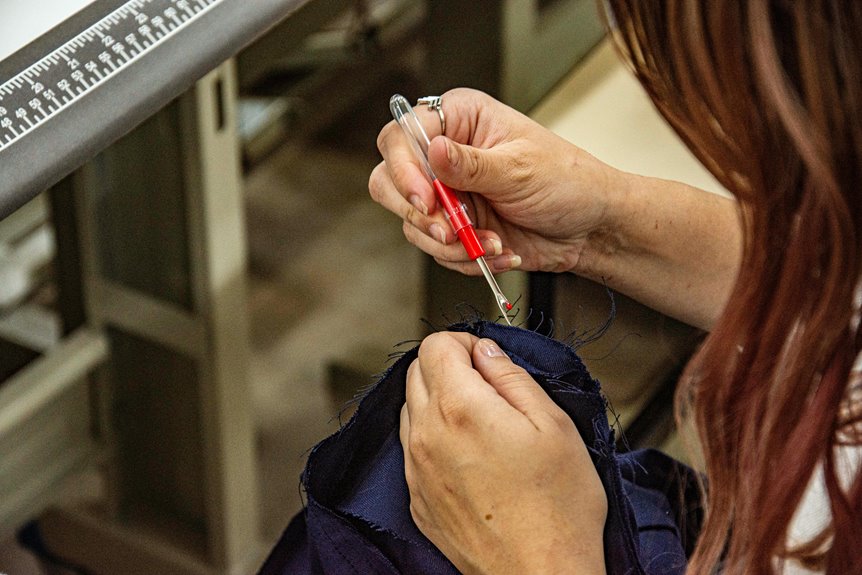When you choose Kevlar thread fabric for high-strength projects, you get exceptional tensile strength, heat resistance, and durability that outperforms conventional threads. You’ll need heavy-duty sewing machines and strong needles since Kevlar’s stiffness and abrasion resistance demand special tools. It’s perfect for gear exposed to extreme conditions, like protective clothing and automotive parts. You’ll also want to learn the best techniques to handle Kevlar’s challenges and maximize the longevity of your stitched products.
Table of Contents
Key Takeaways
- Kevlar thread offers superior strength, heat, and abrasion resistance, ideal for sewing high-stress, heavy-duty fabric projects.
- Use heavy-duty sewing machines with titanium or leather needles sized 90/14 or larger for optimal Kevlar stitching.
- Maintain slow, even sewing with longer stitch lengths (3.0–4.0 mm) to prevent thread breakage and tension issues.
- Handle Kevlar thread carefully, using wax or conditioners to reduce fraying and improve knotting.
- Kevlar thread is common in protective gear, aerospace, automotive, and outdoor applications requiring durable, heat-resistant seams.
Properties That Make Kevlar Thread Ideal for Heavy-Duty Sewing
Because Kevlar thread combines exceptional strength with heat resistance, it stands out as the best choice for heavy-duty sewing projects.
When you use Kevlar, you benefit from its incredible tensile strength, which means your stitches won’t break easily under stress. This thread also resists abrasion, so it holds up well against friction and wear, ensuring your sewn items last longer.
Plus, Kevlar’s heat resistance lets you work with materials exposed to high temperatures without worrying about the thread melting or weakening. You’ll also appreciate its chemical resistance, which protects your projects from damage caused by oils, solvents, or acids.
Comparing Kevlar Thread With Conventional Sewing Threads
When you choose a sewing thread, understanding how Kevlar compares to conventional options can help you make the best decision.
Kevlar thread offers exceptional strength and durability that typical cotton or polyester threads can’t match. It’s designed for heavy-duty projects where resistance to heat, abrasion, and cuts matters most.
Here’s how Kevlar stands out:
- Strength: Kevlar is considerably stronger, ideal for high-stress seams.
- Heat Resistance: It withstands much higher temperatures without melting.
- Abrasion Resistance: Kevlar resists wear and tear better than standard threads.
- Stretch: Conventional threads have more stretch; Kevlar is more rigid.
- Cost: Kevlar thread is pricier but worth it for durability and safety.
Choosing Kevlar means you’re prioritizing longevity and performance in your sewing projects.
Essential Tools and Techniques for Sewing With Kevlar Thread
Sewing with Kevlar thread demands the right tools and techniques to guarantee strong, durable seams.
First, use a heavy-duty sewing machine with a strong motor and adjustable tension since Kevlar is thicker and tougher than regular thread. Equip your machine with a titanium or leather needle sized 90/14 or higher to prevent breakage.
When threading, handle Kevlar carefully to avoid fraying; consider using wax or thread conditioner for smoother stitching. Sew slowly and evenly to maintain control, and opt for a longer stitch length—around 3.0 to 4.0 mm—to reduce heat buildup and needle stress.
Finally, always test on scrap material to fine-tune your settings before starting your main project. These steps guarantee your Kevlar sewing stays strong and reliable.
Common Applications for Kevlar Thread in Various Industries
Kevlar thread plays an essential role across many industries thanks to its exceptional strength and heat resistance.
When you use Kevlar thread, you tap into its ability to provide durable, reliable seams in demanding environments. You’ll find it widely used where standard threads just won’t hold up.
Here are some common applications you might encounter:
- Protective clothing, like firefighter suits and motorcycle gear
- Aerospace components requiring lightweight yet strong stitching
- Automotive parts, including airbags and reinforced upholstery
- Industrial gloves and safety equipment for cut resistance
- Outdoor gear such as tents and sails exposed to harsh conditions
Tips to Enhance Durability When Using Kevlar Thread
Although Kevlar thread is incredibly strong, you can still take steps to boost its durability in your projects.
First, always use the right needle size to prevent damaging the thread while sewing. Keep your tension settings moderate; too tight can weaken the thread, and too loose may cause gaps.
When joining pieces, reinforce seams with double stitching to enhance strength. Avoid exposing Kevlar thread to prolonged UV light, which can degrade its fibers over time.
Store your materials in a cool, dry place to maintain thread integrity. Finally, trim excess thread ends carefully to prevent fraying, and consider using a heat seal or adhesive to lock stitches in place.
These small practices help you get the most durability from Kevlar thread in your work.
Challenges to Anticipate When Working With Kevlar Thread
When you work with Kevlar thread, you’ll quickly notice it behaves differently from standard threads, and that can present several challenges. Its stiffness and low elasticity demand careful handling, or you might struggle with thread breakage or tension issues.
You’ll also find it’s tough on needles, requiring special, stronger ones to avoid damage. Additionally, Kevlar’s heat resistance means traditional ironing techniques won’t soften stitches, complicating seam finishing.
Expect difficulty in knotting, as the thread resists conventional knots and can slip. Finally, cutting Kevlar needs sharp tools to prevent fraying.
- Kevlar thread stiffness complicates threading and tension control
- Requires specialized, durable needles
- Heat resistance limits ironing options
- Knots can slip or fail without proper technique
- Cutting demands sharp blades to avoid frays
Care and Maintenance of Products Sewn With Kevlar Thread
Since products sewn with Kevlar thread are designed for durability and strength, you’ll want to maintain them properly to preserve these qualities. Avoid harsh chemicals and excessive heat, which can degrade the fibers. Regularly inspect seams for wear or damage, and clean gently with mild soap and cool water. Store items away from direct sunlight to prevent UV damage.
| Care Aspect | Recommendation |
|---|---|
| Cleaning | Use mild soap and cool water |
| Drying | Air dry, avoid heat sources |
| Inspection | Check seams monthly |
| Storage | Keep in shaded, dry place |
Frequently Asked Questions
Can Kevlar Thread Be Dyed Different Colors?
You can’t easily dye Kevlar thread different colors because its fibers resist most dyes. Instead, manufacturers usually produce it in specific colors during production, so you’ll need to choose from available options rather than dyeing it yourself.
Is Kevlar Thread Safe for Skin Contact in Clothing?
You’d think touching Kevlar thread would give you superpowers or burn your skin, right? But don’t worry, it’s actually safe for skin contact in clothing, as long as it’s properly woven and not frayed.
How Does Kevlar Thread React to Extreme Temperatures?
You’ll find Kevlar thread withstands extreme temperatures well—it resists heat up to about 450°C without melting or burning. However, it degrades if exposed to temperatures beyond that, so handle it carefully with intense heat.
Are There Eco-Friendly Alternatives to Kevlar Thread?
You can choose sustainable, strong substitutes like spider silk or bamboo-based threads. These eco-friendly alternatives offer fantastic flexibility and formidable fiber strength, fitting your needs without harming the environment or compromising durability.
Can Kevlar Thread Be Recycled or Repurposed?
You can’t easily recycle Kevlar thread because it’s a tough synthetic fiber. However, you can repurpose leftover pieces for reinforcing gear or craft projects, extending its life instead of throwing it away.
- Woven vs. Knitted vs. UD: Understanding Aramid Fabric Types - June 22, 2025
- Aramid Fabric in Tarkov: Your Guide to Finding & Using Erinaceous Armor - June 22, 2025
- Where to Find Aramid Fabric For Sale: An Online Buyer’s Guide - June 22, 2025







